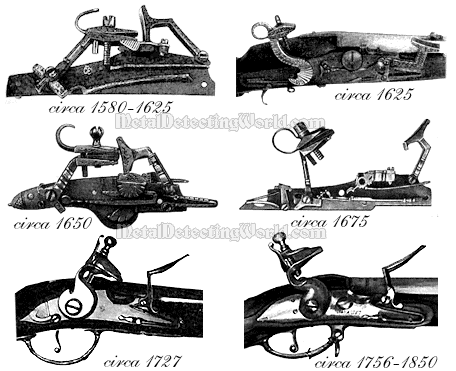Part I - Metal Detecting at the Swedish Tavern Site, page 41
Discovery of 17th Century Musket Flint with Lead Pad
One relic find that made me feel the touch of history the most was a musket flint enclosed in a lead flint holder or flint pad. If it was not for this lead pad, I would not be able to find the flint, a non-metallic object.
I was glad that I followed my old golden "rule of thumb": while treasure hunting in dim-light or lightless conditions, collect ALL your finds and DO NOT discard them until you ID them after cleaning at home. I thought I had just found a wad of foil when I dug up this outstanding relic. A happy and joyful moment came later when I rinsed the dirt off the "wad" at home.
Both Sides of a Musket Flint with Lead Flint Pad, ca. mid-16th to late-18th Century
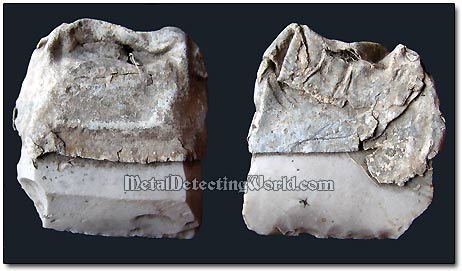
Before I had found a flint only once when I was recovering a musket lock plate at the Rev War site in Upstate New York. That flint (honey-colored French type) was accidentally excavated as a "by-product" along with dirt (I still remember how excited I was at that moment!). Now I was even more excited imagining a person folding the lead foil around this flint some 350 years ago! And now I could see that person's handywork as if it was done yesterday - to me it was just incredible!
Side View of Flint in Lead Sheath
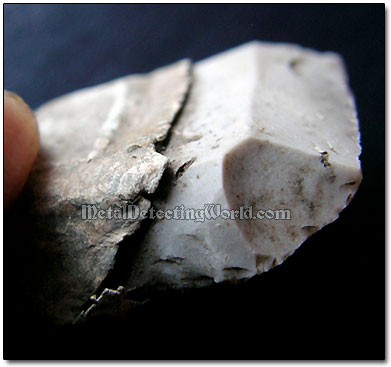
Some detectorists might say, "What is so incredible about it?" Well, I guess any vivid display of personal workmanship, whether it is a self-made love charm or finger-folded lead foil sheathing a flint - very personalized items from a long time ago, amazes me!
Lead holder or pad was placed on napped flint to secure its firm position between the jaws of the rotating "cock" (or "hammer") of the lock (see a diagram below). For firing, the cock was rotated back against a spring. When the trigger was pulled, the cock snapped forward hitting the face of the hardened steel "frizzen" (or "battery").
This flint-on-steel action created sparks that fell into the curved "flash pan" (which became uncovered as the frizzen pivoted upward). A small amount of black powder had already been poured into the pan during the loading process. It now flashed and sent flame through a small touch hole in the side of the barrel to ignite the main charge of loose black powder inside.
Parts of Flintlock Mechanism
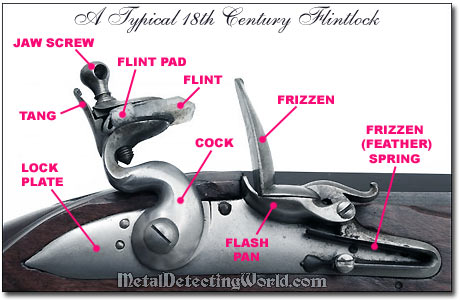
Flintlock - Brief Historical Facts:
The development of firearm lock mechanisms proceeded from Matchlock (circa 1360s) - a lock holding a burning slow match in a clamp at the end of a small curved lever known as the serpentine, to Wheellock (ca. 1500) - a lock using a rotating steel wheel to provide ignition, to Snaplock (ca. 1540s) - a lock striking flint against steel but not having the frizzen, to Snaphaunce (ca. late 1550s) - a lock with the pan cover (opened automatically) separate from the frizzen and has no half-cock on the tumbler, and Miquelet (ca. 1570s) with its combined battery and pan cover - the final innovative link that made the true flintlock mechanism possible.
French courtier Marin le Bourgeoys fitted these various features together and made the first firearm incorporating a true flintlock mechanism for King Louis XIII in 1610. The new system quickly became popular throughout Europe by 1630. The flintlock musket - a muzzle-loading smoothbore long gun that was loaded with a round lead ball, was the main firearm of European armies between 1660 and 1840. Typical musket calibers ranged from 0.5 inches (13 mm) to 0.8 inches (20 mm). A typical smooth bore musket firing at a single target was only accurate from about 50 yards (46 m) to 70 yards (64 m).
Russian Flintlock on a Fusil, ca. 1650
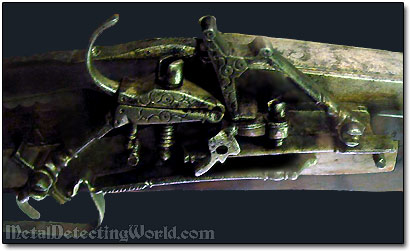
After 200 years of being widely used, the flintlock was replaced by percussion cap (invented by the Reverend Alexander John Forsyth, a Scottish minister, in 1807) and, later, cartridge-based systems in the early-to-mid 19th century. Even though they have long been considered obsolete, flintlock weapons continue to be produced today. Not only are these weapons used by modern re-enactors, but they are also used for hunting, as many U.S. states have dedicated hunting seasons for black powder weapons, which includes both flintlock and percussion lock weapons.
Development of Flintlock Design
